|
Monogram's 1/48 scale
F-84F
Thunderstreak
by
Wayne Hui
|
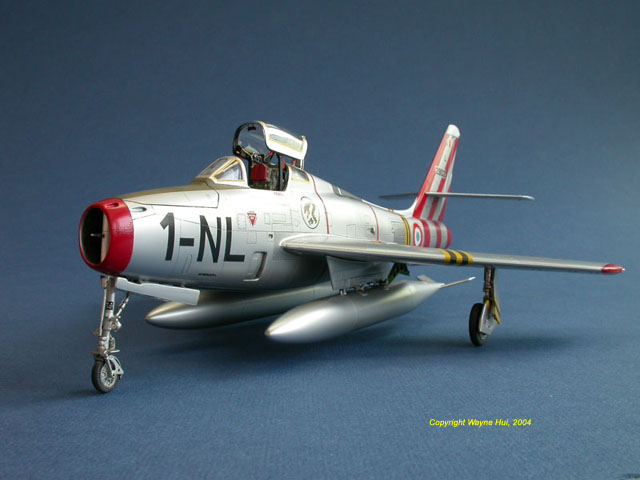 |
|
Republic F-84F
Thunderstreak |

HyperScale is proudly supported by
Squadron.com
The Suez Canal
was opened in 1869, having been financed by France and the Egyptian
government. Later, the Egyptian government's share was bought by the
British; British banks and business held a 44% stake. The canal was of
strategic importance, being the link between Britain and its Indian
Empire, and the area as a whole was strategic to North Africa and the
Middle East. The importance of the Canal was shown during both World
wars.
In the summer of
1956, Egyptian President Nasser (Formerly Colonel Gamal Abdel Nasser),
in his nationalistic effort to reform his country and re-established
Arab pride, nationalized the Franco-British Suez Canal Company. This
greatly angered Britain and France as this deprived them of the
estimated $25 million dollar annual profit from commercial ocean traffic
through the canal.
Britain and
France held a secret meeting with Israel outside Paris to organize an
invasion of Egypt to take back control of the canal. Israel was amenable
to the pact as any effort to weaken their strongest Arab enemy, which at
that time was Egypt, was welcomed. Britain and France, being a partner
in NATO, did not inform the United States of their plan.
The three Allies
were concerned about the strength of the Egyptian Air Force (EAF), the
fighting capability of its aircrew, the newly purchased MIG 15, the
Illusion 28 Bombers, the heavy Stalin Tanks, the self-propelled SU-100
guns in addition to other unknown types of Russian and Czech arms, but
especially the preparedness of Czech and Soviet 'advisers' to fight
alongside the Egyptians. To counter these threats, large air forces had
been deployed to Cyprus and Malta by the Britain and France and many
aircraft carriers were deployed. One of the French Air Force (Armee de
l'Air), 201 Fighter Squadron (Ramat David), deployed 18 Republic F-84F
Thunderstreak with 25 pilots to operate from Cyprus and Israel.
Operation Kadesh
On October 29,
1956, Israeli troops invaded the Gaza Strip and Egypt's Sinai Peninsula
and quickly overcame opposition as they raced for Suez. The next day,
Britain and France, following their part of the script, offered to
temporarily occupy the Canal Zone and suggested a 10 mile buffer on
either side which would separate the Egyptian forces from the Israelis.
Nasser of course refused, and on October 31, Egypt was attacked and
invaded by the military forces of Britain and France.
Operation Musketeer - initially called Hamilcar
The Anglo-French
air operations against Egypt to retake the canal began with attacks on
twelve Egyptian airfields in the Canal Zone and the Nile Delta. The
first phase of the assault, between October 31 and November 1, was
designed to destroy or neutralize the Egyptian Air Force.
De Havilland
Venoms of the RAF and Arm é e de l'Air Thunderstreaks from Cyprus
pounced on canal zone airfields. Royal Navy Hawker Sea Hawks and de
Havilland Sea Venoms from the carriers Eagle, Bulwark and Albion swooped
on three fields in the Cairo area. The flak was light, and all the
attackers returned. By early afternoon, the carriers were 50 miles
offshore and launching a fresh sortie every few minutes. On Cyprus,
planes were taking off or landing at the rate of one a minute. The jets
were joined by turboprop Westland Wyverns from the British flattops and
propeller-driven Vought F4U Corsairs from the French carrier Arromanches,
which was accompanied by Lafayette, carrying Grumman TBM Avengers and
helicopters.
The air
operation was so effective that the EAF was destroyed in a day. Egyptian
air fields were later secured by the Anglo-French airborne forces as a
preliminary to a major sea borne assault with the aim of gaining control
of the Suez Canal.
The hostile take
over of the canal caused international condemnation at the UN. The
Soviet Union threatened to intervene on Egypt's behalf with all manner
of modern weapons. At the same time, the Soviet Union had an
anti-Communist uprising in Hungary to deal with. The United States was
deep in the Cold War with Soviet Union and fearing escalation of the
conflict pressured Britain, France and Israel into agreeing to a
cease-fire and withdrawal from Egypt.
The war itself
lasted for only a week, and invading forces were withdrawn within the
month. Egypt suffered great losses to its armed forces but did not lose
the objective. After this conflict, Egypt firmly aligned itself with the
Soviet Union, which armed Egypt and other Arab nations for the
continuing struggle against Israel. The British Prime Minister Sir
Anthony Eden resigned in January 1957 as a result of the Suez fiasco.
The result of the conflict symbolically marked the end of the British
Empire. This event prominently demonstrated the influence of the two
Superpowers which drove Geopolitics at that time. Other partners such as
Britain and France could no longer “go at it” by themselves without
buy-in and support from the NATO partners, especially the United States.
Their “gun-boat” diplomacy from the 19 th Century was dead.
French Thunderstreaks
The F-84F was
supplied in large numbers to NATO air forces by the United States via
the MAP (Military Assistance Program). Out of the 2711 Thunderstreaks
built, 1301 were transferred to Europe for service with the air forces
of allied nations.
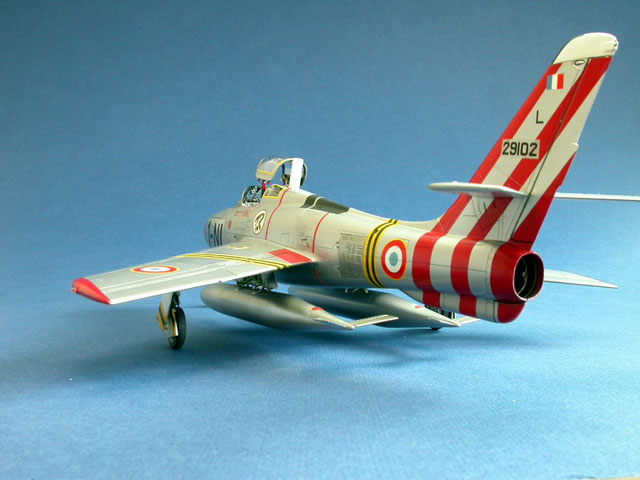
The Armee de
l'Air received its first Thunderstreaks in 1955. They equipped the the
1st, 3rd, 4th, 6th, and 11 th Escadres. It was in French service that
the Thunderstreak saw its only actual combat during the Suez Crisis. 36
French Thunderstreaks from the 1st Escadre flew to the Israeli base at
Lyddia and at the same time F-84Fs from the 3rd Escadre moved to
Akrotiri on Cyprus. The 3rd Escadre later also operated out of Israel.
The French Thunderstreaks at Lydda supported the Israeli forces that
invaded Sinai on October 29. Cyprus-based units began direct attacks on
Egyptian airfields on November 1. Twenty Egyptian Ilyushin Il-28 bombers
were destroyed on the ground and one Il-28 was shot down by these Lydda-based
units. These operations were concluded on November 6, and only one F-84F
was lost. The French F-84Fs were flown for over 10 years until replaced
by Mirage IIIE in the mid 1960s.
Monogram and
Heller both produced a model kit for a 1/48 scale F-84F. Both kits have
raised panel lines. A quick summary of both kits is follows.
The Heller kit
appears to have a more accurate rear fuselage. The speed brake is
located closer to the wing fairing and the rear fuselage proportion is
correctly shaped when compared to line drawings. The cockpit and
ejection seat is very basic and do not have much details. The wheel
wells are bare without details.
The Monogram
kit’s rear fuselage portion is not properly shaped in that the height
appears to be short. Also, the speed brake is positioned a bit far from
the wing fairing. The cockpit is classic Monogram in its finest. It is
rich in details and even the ejection seat is correct and can be used as
is. The landing gear wheel wells are richly detailed and do not require
additional work. Despite the minor shortfall, it is by far the better
kit.
I choose the
Monogram kit despite its dimensional faults but more than made up with
far better details.
The Model Subject
Most decals for
the F-84F are for US aircrafts. I wanted to do a scheme that not many
people would do. I wanted it to be spectacular and off the beaten track.
When I saw the photos of the French F-84F used in the Suez Conflict in
the November issue of Wing Master, I knew I found exactly what I was
looking for. The aircraft I modeled is an aircraft 52-9012, Coded “1-NL”
from the Armee de l'Air, 1 st Escadre, 1st Squadron. This squadron
operated from the Israeli base at Lyddia. I can not read all French
words, but it appears that aircraft 1-NL was later handed over to Israel
and the Israeli just over painted French insignia with the Star of David
and changed 1-NL to 1-NX.
I begin the
project by dry fitting the major parts. Everything goes together very
well except for the wing to fuselage joint and the fit of the clear
parts to the fuselage.
The model goes
together in accordance to the kit instruction sheet with no major
problems. This model is a tail sitter. Instead of using the ugly clear
leg (crutch) that the instruction sheet tells me to use, I added a few
lead fishing anchors into the nose section to weigh down the front end
before I seal the two fuselage halves together. The nose gear on this
model is most delicate. To prevent the nose gear from breaking, I made
sure I added just enough weights to keep the nose down and no more.
The Monogram
cockpit details are excellent right out of the box. From reference
photos I saw that there not too much improvement I can add. The seat is
the correct later style seat; the early seats were the ones used by the
F-84E and G. I removed the molded on seat belts and hoses and replaced
them. The seat belts were made from lead foils from wine bottles and the
hoses were made from fine copper wires by wrapping it around the same
type of fine wire. A round bar was added to the back of the seat as per
photo details.
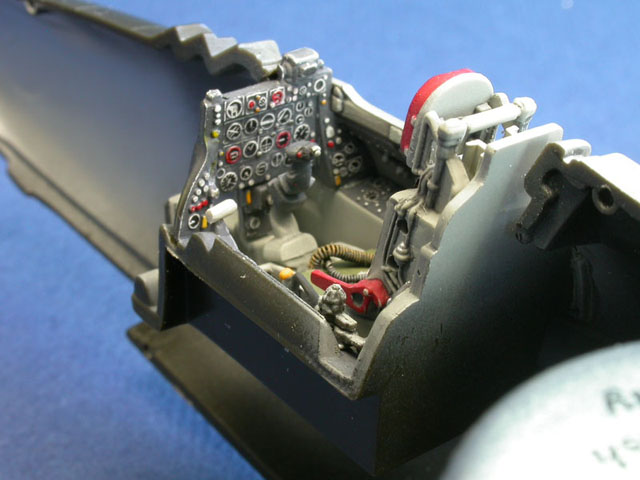
The instrument
panel and side panels have tremendous amount of details. To bring the
details out, I use my 7 steps painting process. I first spray paint them
with flat white then followed up with a coat of Future. Then I spray on
a mix of dark grey Model Master enamel paint. When that dried, fine
raised details from the instruments are brought out by carefully wiped
off with a fine tip brush wet with enamel paint thinner. Again the whole
thing is recoated with Future to seal the previous work in preparation
to added other washes and colour. This method is far better than dry
brushing method typically used by most modelers.
The wind shield
and rear windows do not fit well to the fuselage. To eliminate the
unsightly gaps I attached these parts to the fuselage, after painting
all the cockpit parts, with liquid cement. The gaps are filled in with
Tamyia putty and wet sanded.
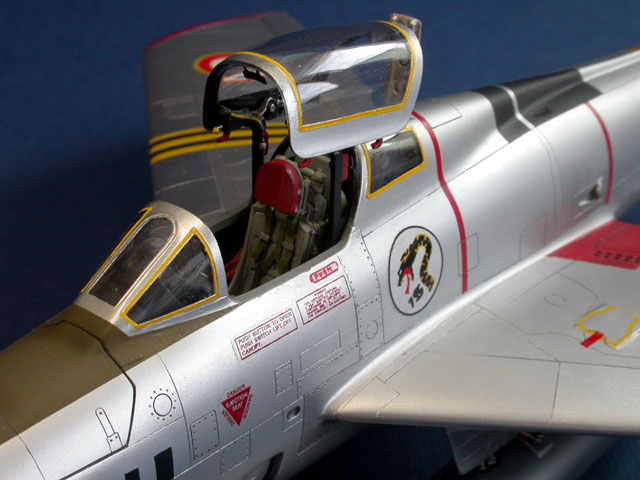
The canopy comes
with parts for the forward arm fitting and inside frame details. All
that is needed is just some careful painting and adding a yellow handle
to the front of the right hand side frame. A photoedge mirror was added
to complete the details for the canopy.
The landing
gears provided is beautiful. It wheels have so much details as is. With
just a light wash, the details just popped out.
Building the
rest of the kit is very straight forward by just following the kit
instruction sheet. Everything fit reasonably well and required only
minor amount of putty at the wing to fuselage joint.
The main wheel
bays were painted with green zinc chromate and detailed before they are
put together.
To prepare for
painting a natural metal finish, all exterior surfaces were wet sanded
with fine grit wet sanding paper to remove as much scratches as
possible. This is followed up by buffing with a plastic polishing
compound.
The model was
painted with the Alclad grey primer and the Alclad II Aluminum paint
system. Selected panels were painted with Polished Aluminum, Dark
Aluminum, and Matt Aluminum. The red stripes were carefully masked off
and painted with Model Master Guard Red. The identification bands were
masked off and painted with Gunze paint. The mask was created for each
aircraft code letters and painted with Gunze flat black paint.
Decals for the
French F-84F in the Suez conflict is hard to find. Carpena is only one
that I know of that made the markings for the aircraft I want to do. I
special ordered the decals in and had great hopes. This was quickly
dashed as I dip in my first test decal and it disintegrated into many
tiny pieces! I dipped another test piece in and it also disintegrated.
Even if I can’t use other parts of the decal sheet, I must be able to
make use of the two squadron badges for SPA 69 (Rencontre de chat) and
SPA 88 (serpent). I sprayed the decal sheet with a coat of Gunze gloss
clear in hope the clear coat will hold the decals together long enough
for me to apply to the model. This worked. I only used the squadron
badges from the sheet. The small text on the sheet is totally illegible
and the panel marking stripes were so wide that it would have been
laughable if used.
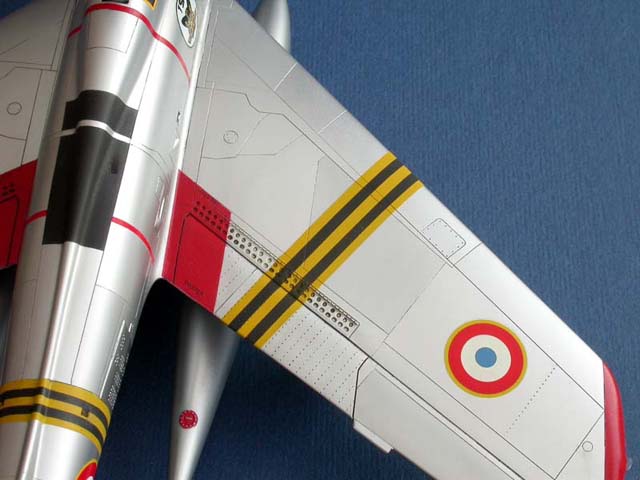
Much thanks to
Bruce Kennedy and Uncle Rick of our GOMBs Model Group who gave me their
French national insignias without which I could not finish this model.
I rate this
F-84F kit as the best Monogram kit I have ever built. It fits together
well and is so well detailed right out of the box. Although I could have
done one of the several US aircraft with the decals from SuperScale, I
am glad I went off the beaten track and modeled a French aircraft that
actually saw action. It was a challenge to get the markings and masking
all the stripes. It is not a perfect model by any means, but it was
worth the effort and I am happy with the finished results.
Wayne Hui
http://www.modelart.ca
1. Wilfred P. Deac and originally published in Military History Magazine
in April 2001
Click on the thumbnails
below to view larger images:
Model, Images and Text Copyright ©
2005 by Wayne Hui
Page Created 11 February, 2005
Last Updated
11 February, 2005
Back to
HyperScale Main Page
|
Home
| What's New |
Features |
Gallery |
Reviews |
Reference |
Forum |
Search